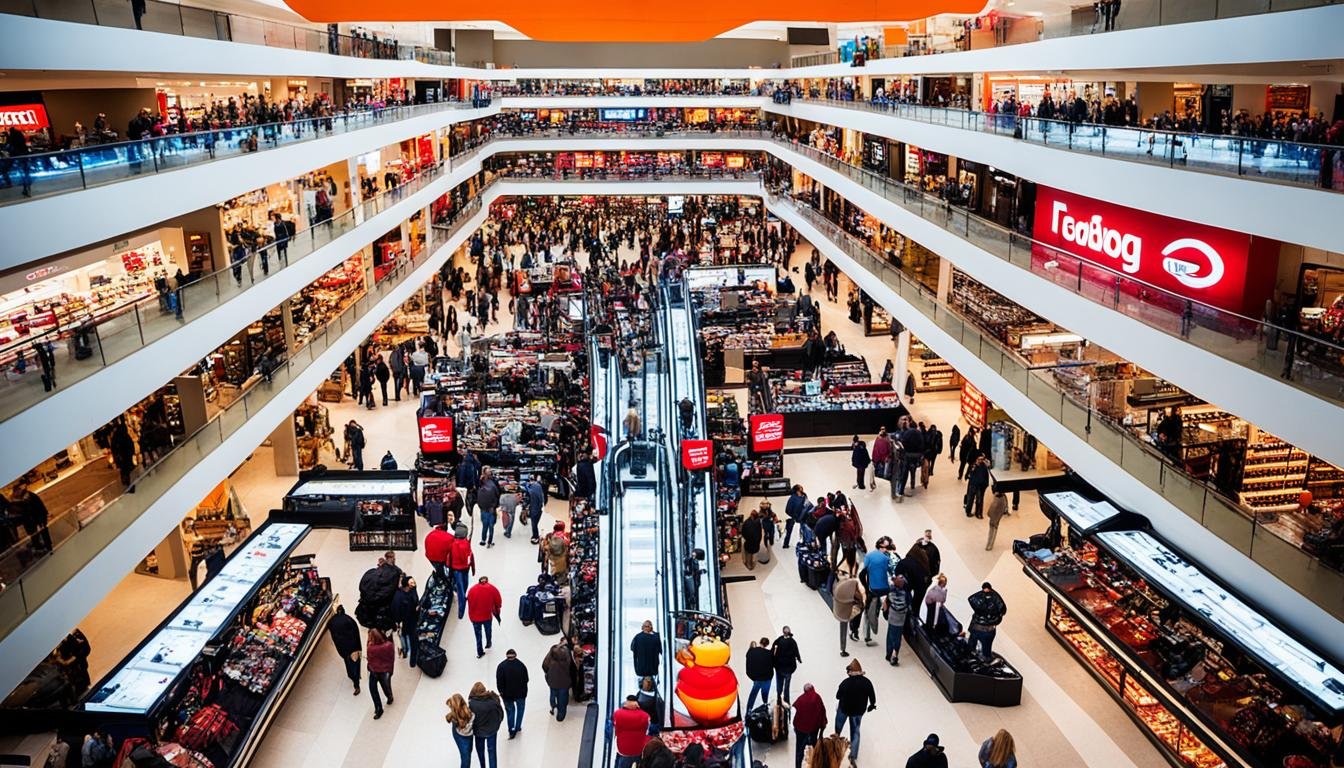After World War II, the United States changed a lot. American soldiers came back to a very different America. They found a booming economy. This was thanks to the production during the war. As a result, young people had more money to spend.
At the time, many young couples were getting married and having kids. They were living in new homes, often in the suburbs. Thanks to programs like the G.I. Bill of Rights, owning a home became possible for many.
In the 1950s, buying things for the home was seen as patriotic. It supported the American way of life. It shows how Americans preferred buying useful things over expensive, fancy items.
Key Takeaways : American Shopping Culture
- The post-WWII economic boom led to a surge in American consumer spending and a rise in home ownership.
- Purchasing household goods was seen as a patriotic duty, helping to spur economic recovery and align with traditional American values.
- The federal government and the public viewed consumerism as a way to bridge class divides and reinforce traditional gender roles.
- The growth of suburbs and increased car ownership were critical factors in shaping American shopping habits and culture.
- Television became a powerful medium for advertisers to create new desires and influence consumer behavior.
The Rise of American Consumerism After World War II
After World War II, Americans looked to buy cars, televisions, and other new things. Being a good buyer was considered patriotic. It helped the nation’s economy grow after tough times.
People focused on home and family items like refrigerators and vacuum cleaners. This choice showed they cared about their families. It also supported old American values of doing what’s practical and right.
Pent-up Demand and Spending Power
After the war, Americans were eager to buy. They had saved up a lot of money during the war. This burst of spending helped create a strong consumer culture.
The Good Purchaser: A Patriotic Citizen
Buying new and more things was seen as helping the country. It was part of the American Dream. Taking part in this consumption was considered a way to support the nation’s well-being.
Pragmatic Spending on Household Goods
Americans bought things like washing machines instead of luxury items. This focus was on improving family life while sticking to traditional values. It made spending feel OK because it was practical and not wasteful.
The Booming Television and Automotive Industries

Suburban populations were growing, and more people needed cars. This meant that many could buy their first car. At the same time, families from all income levels were buying TVs at a rapid pace.
Some TV shows spoke to the working and middle classes. They showed ads at a perfect time to make people want to buy more things. This shift was seen as a path to overlook differences in class. It also focused on tradition in family roles. Now, even working-class people could afford things that were once considered out of reach.
Suburban Growth and Car Ownership
After World War II, suburbs grew quickly. Families found they needed cars to live outside cities. As a result, more people, even from the middle class, could buy their first car. This showed the rise of a culture where buying things was important.
Television’s Impact on Advertising and Consumer Desires
TV became popular in American homes very fast. Shows that resonated with the working and middle classes were great for ads. This made people want to buy more.
Television changed what people wanted and how they shopped. As a result, the idea of a good life, as seen on TV, became something many could dream of having.
The American Dream and Upward Mobility

After World War II, American consumerism grew, linked to the American Dream and upward mobility. The government and people aimed to lessen class differences. They focused on reaching traditional gender roles and working-class folks.
Tupperware: Selling to Buy
The Tupperware brand stood out in this shift, showcasing the perfect efficient home and kitchen. It was designed for housewives to keep food fresh and orderly. By hosting parties, people could earn appliances and other consumer goods.
The Efficient Home and Consumer Goods
Seeing consumerism rise, the government and society aimed to bring the middle class nearer to the American Dream. They made the comforts of a cozy, suburban life available to more working-class families. Tupperware and similar products symbolized this growing prosperity and social mobility.
The Birth of the Shopping Mall

In 1938, Victor Gruen, a socialist architect, arrived in New York City. He later designed what would become a key part of American life after the war: the shopping mall. Gruen wanted the mall to be the heart of a community. He planned for it to be surrounded by homes, parks, schools, and hospitals. He called it a “third place,” like the Greek agora or medieval markets, for people to meet and socialize.
Victor Gruen’s Vision: The Mall as a Community Center
Gruen had a bold dream for the mall. He wanted to create a space that was not just for shopping but for community life. Americans would come together, shop, and enjoy their neighborhood. This idea was very different from the usual shopping areas with just a main street or square.
Southdale Shopping Center: The First Enclosed Mall
Yet, what Gruen built in 1956, the Southdale Shopping Center, turned out differently. It was just a shopping mall with a big parking lot. It didn’t match his vision of a lively, mixed-use area where the community thrived. The final design focused more on shopping than on bringing people together. This shift from his original idea marked the start of a long-lasting American shopping trend.
The Rise of Mall Culture

Before Southdale mall, the Lakewood Center mall was built in Lakewood, California. It was the largest in the U.S. parking 10,000 cars. By 1960, 4,500 malls had opened. And in 1975, it jumped to 16,400, with a third of retail spending going to them.
Lakewood Center: The Largest Open-Air Mall
Mall culture soon appeared in Hollywood movies. Films like “Dawn of the Dead” and “Fast Times at Ridgemont High” showed how important malls were. They were key parts of shopping and lifestyle, reflecting the changes in American culture.
Malls in Pop Culture: Movies and Subcultures
Malls didn’t just change shopping. They became important cultural and community spots. Whether it was teens at the food court or families shopping, the mall was central. It truly became part of the American way of life.
American Shopping Culture and the Global Marketplace

Cultural differences greatly influence how Americans shop and what they buy. In cultures that focus on the group, people often think about what others need before making choices. They like colors that are popular and products that have been improved little by little. On the other hand, those in individualistic cultures like North America and Western Europe prefer things that show their personal freedom and style, such as particular brands.
Cultural Differences in Consumer Behavior
These differences show up in many parts of the shopping experience, from what’s on a website to how things are priced or displayed in stores. People from collectivist backgrounds, for instance, might not be intrigued by store brands. They often value well-known name brands more. Knowing about these differences is key for retailers and brands that want to do well all over the world.
Brand Architecture and Cultural Preferences
Brand architecture should also change to suit different cultural needs. Shoppers who come from places where groups are more important might like brand spin-offs that highlight the main brand’s strength. Brands that mix global and local cultural features can catch the eye of various consumer groups worldwide.
Luxury Brands and Mass-Market Appeal
Luxury brands versus mass-market appeal is another place where cultural differences show their power. While American individuals might choose products that speak to who they are, those in group-focused cultures might prefer items that say something about their social standing and sense of belonging. Understanding and meeting these deep cultural wishes is vital for companies that want to make it big in global retail.
The Decline and Reinvention of Malls

The world of American shopping has changed a lot. Malls were once the king, but they’re not what they used to be. By 2022, a quarter of these once-popular malls had shut their doors, just as experts had forecast. The U.S. went from 1,500 malls to 1,150 between 2005 and 2022, a big drop of 23%.
The Mallpocalypse: Mall Closures and Conversions
With many malls closing, different uses are popping up. For example, California is turning empty “big box” stores into places for people to live. This change shows how malls are trying to stay relevant, finding new ways to meet people’s needs.
Repurposing Malls for Housing and Other Uses
Malls are no longer just for shopping with so many closing down. They’re becoming places for living, learning, and more. Some turn into places where the whole community can gather, or they provide essential healthcare. The goal is to make these spaces useful again, fitting into what people want and need.
American Shopping Culture: A Unique Consumer Journey

American shopping culture is all about celebrating independence and self-expression. This mindset is quite the contrast from other parts of the world. In non-Western cultures, for instance, people often think about others when they shop. They prefer items everyone knows and loves.
Individualistic vs. Collectivistic Shopping Behaviors
These differences affect how we see prices, displays, and service. For those who lean toward collectivism, brand loyalty is huge. They don’t find private labels as appealing. But, brand extensions? Those fit right in. Meanwhile, individuals who value their uniqueness look deeper. They want to see the heart and soul of a product.
Cultural Influences on Pricing, Displays, and Customer Interaction
Where you shop is more than just a place. It’s a reflection of your culture. This shapes how businesses set prices, show off their goods, and interact with you. To really connect with customers, brands must tune into these cultural differences. This helps them create experiences that truly resonate.
The Future of Retail: Adapting to Cultural
American shopping is changing fast. Retailers need to change with it. E-commerce is shaking up the scene, causing many malls to close. But, this change also gives a chance to make retail better.
Different cultures have different shopping habits. Americans like to show off their uniqueness. But, in collectivist cultures, people seek items that help their community. Retailers need to think about these cultural gaps. They should design marketing and store experiences that fit everyone.
Sustainability and ethics are also big deals now. Young people are looking closely at a brand’s values. They want to buy from companies that do good things. Retailers need to show they care about the planet and society to win these customers over.
The best retailers will mix digital and physical shopping seamlessly. They will also celebrate their customers’ diverse cultures. By doing this, they can stay popular in the ever-changing American shopping world.
Also Read : Earn Rewards While You Shop: Loyalty Points Shopping Guide
FAQs
Q: What is the significance of American Shopping Culture?
A: American Shopping Culture is significant as it reflects the nation’s fashion trends, consumer behavior, and social influences.
Q: How does clothing play a key role in American Shopping Culture?
A: Clothing is a key aspect of American Shopping Culture as it helps individuals express their identity, status, and personal style.
Q: What are some characteristics of the mass market in American Shopping Culture?
A: The mass market in American Shopping Culture tends to offer clothing solutions that are widely available, affordable, and aimed at a large consumer base.
Q: How does social media contribute to shaping American Shopping Culture?
A: Social media platforms play a significant role in influencing shopping trends, promoting brands, and connecting consumers with fashion influencers.
Q: What are the impacts of labor conditions on American Shopping Culture?
A: Labor conditions in clothing production can have a significant effect on the ethics and sustainability of American Shopping Culture.
Q: How has the concept of “fast fashion” revolutionized American Shopping Culture?
A: The rise of fast fashion has led to a tendency for consumers to locate cheap and trendy clothing items quickly, but it also raises concerns about environmental impact and labor conditions.
Q: What role do influencers play in influencing American Shopping Culture?
A: Influencers on social media platforms often promote specific clothing brands or trends, impacting consumer buying decisions and engagement with fashion content.
Q: How has the geographical location of stores affected American Shopping Culture?
A: The geographical location of stores can influence shopping patterns, accessibility, and the cultural identity associated with certain areas in American Shopping Culture.





